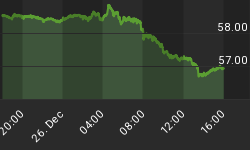There is a dichotomy going on in the transportation sector. The railroad industry, by and large, remains in a bull market, and one could postulate that this group may provide market leadership once that elusive bottom is more solidified. On the other hand, the airline industry has been plagued by a weak consumer, a slowing economy, and high fuel prices. Is it any wonder that the Amex Airline Index is probing its all time lows last seen in 2003? In the end, for the market to go higher and as a sign of an improving economy the transportation sector must show leadership. The railroads may provide that leadership as the airlines begin to solidify their own bottom.
Figure 1 is a monthly chart of the Dow Jones Transportation Index. I have shown this chart for several months now. The trend line break in the face of multiple divergences occurred 8 months ago and this was bearish. For the last two months, the transport index has been working higher, and I contend (and until proven other wise) that the right shoulder of head and shoulders top is forming. Prices are currently are at 5000 or in the upper end of the resistance zone.
Figure 1. Dow Jones Transportation Index/ monthly
A weekly chart (see figure 2) of the Dow Jones Transportation Index is more instructive and shows that prices have broken above a head and shoulders bottoming pattern. This breakout has a price projection that should carry this key index back to its old highs in the vicinity of 5400. The right shoulder of the head and shoulders topping pattern hypothesis isn't too far fetched.
Figure 2. Dow Jones Transportation Index/ weekly
In any case, the Dow Jones Transportation Index is made up 20 stocks with representation from the air delivery and freight service, railroad, trucking, and shipping industries. Of this group, the railroads are clearly the strongest. The airlines are severely underperforming. The others appear to be performing in line with the market.
So why are the railroads outperforming? It would seem that certain parts of the economy (i.e., moving of raw materials for export) are not in a slowdown at all or it just may be that the railroad industry is telegraphing a stronger economy in the months ahead. A couple of charts of companies in this industry should illustrate my point, and this should provide you with further impetus to pursue fundamental research on these individual companies.
Figure 3 is a monthly chart of CSX Corporation (symbol: CSX). My first thought, when I saw this chart, was: what bear market? Although somewhat extended, I just wanted to show you this very bullish chart of one of the largest capitalized companies in the railroad industry.
Figure 3. CSX/ monthly
Figure 4 is a monthly chart of Burlington Northern Santa Fe (symbol: BNI). The pattern of higher lows remains intact from the 2003 lows, and last month's close over the pivot at $91.57 is bullish.
Figure 4. BNI/ monthly
Figure 5 is a monthly chart of Norfolk Southern (symbol: NSC). For the last 2 years, NSC has been consolidating the explosive move off the 2003 bottom. This consolidation is a very bullish launching pad (or base) for higher prices (see gray shaded area). With the strong move in the markets to start the quarter, NSC appears to be making its move higher.
Figure 5. NSC/ monthly
Figure 6 is a monthly chart of Canadian Pacific Railway (symbol: CP). This is another bullish chart (with higher lows) that has been basing for about 12 months. Price is at the lower end of the range. A monthly close below the pivot low point at $65.58 is bearish, so this seems like a low risk high reward trade. If the market continues to build bullish momentum, then I would look for CP to move higher.
Figure 6. CP/ monthly
So those are some surprisingly bullish charts, and I would look for the railroad industry to provide leadership if the market continues to work higher.
But all isn't well in transport land. The airline industry is likely to remain weak as the burdened consumer struggles under the weight of tighter credit and falling home prices. Higher oil prices won't help the cause either. Figure 7, a monthly chart of the Amex Airline Index (symbol: $XAL.X), shows best the woes of the airline industry. Last month's close is already below the lowest pivot last seen at the 2003 bottom.
Figure 7. $XAL.X/ monthly
This is an interesting chart. If the 2003 lows hold, then it is likely that oil prices will be moderating and the consumer will be stronger. In other words, I cannot see the airlines moving higher without either of those two conditions being met, and in essence, lower oil prices and a relieved consumer are likely to go hand and hand. A monthly close back above $30 in the index would likely mean a much stronger economy. A very interesting chart to watch.
In summary, the Dow Jones Transportation Index remains a key sector for identifying economic strength. The railroad industry is strongly bullish, and one has to wonder what message is conveyed in this strength. The airline industry is bearish; however, one can easily conceive that a bounce at old lows is in the offering. If a bounce does develop, oil likely will be moderating and this will be seen as a relief to the consumer. Regardless of the events that transpire, the bullish bet at this time is not on the American consumer.
To learn more about our quantitative and disciplined investment approach please visit www.thetechnicaltake.com and sign up for our free weekly newsletter and downloads.
Guy M. Lerner may be reached at guy@thetechnicaltake.com.
















